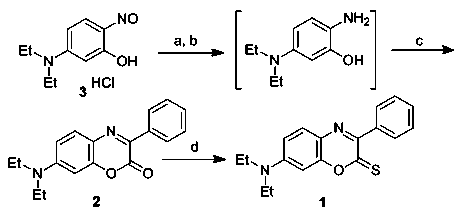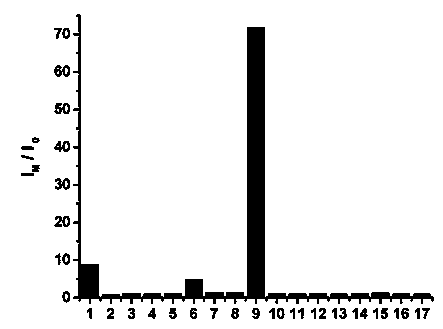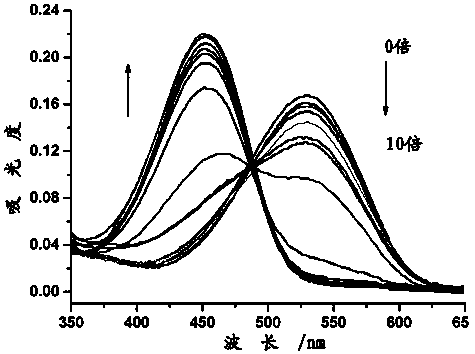Fluorescent probe capable of detecting mercury ions by naked eyes as well as preparation method and application thereof
A fluorescent probe and mercury ion technology, applied in fluorescence/phosphorescence, chemical instruments and methods, luminescent materials, etc., can solve the problems of low sensitivity, complicated operation, difficult large-scale application, etc., and achieve good recognition effect and simple processing , the effect of visual color change is obvious
- Summary
- Abstract
- Description
- Claims
- Application Information
AI Technical Summary
Problems solved by technology
Method used
Image
Examples
Embodiment 1
[0026] Embodiment 1: a kind of fluorescent probe that can detect mercury ion with naked eyes, its molecular structural formula is as follows:
[0027] .
Embodiment 2
[0029] Methods for preparing fluorescent probes for visual detection of mercury ions, such as figure 1 shown, including the following steps:
[0030] (1) Dissolve 23.07 g of 5-(diethylamino)-2-nitrosophenol hydrochloride (0.10 mol, M = 230.69 g / mol) in 200 mL of water, then gradually add 100 ml of Aqueous solution of sodium bicarbonate (0.10 mol, M = 84.01 g / mol). After fully stirring, filter and vacuum dry to obtain the intermediate product 5-(diethylamino)-2-nitrosophenol as a red powder.
[0031] (2) Dissolve 3.88 g of 5-(diethylamino)-2-nitrosophenol (0.02 mol, M = 194.23 g / mol) in 200 ml of absolute ethanol, and add 10% palladium on carbon (0.40 g) to the in the mixture. Under sufficient stirring, hydrogen gas was introduced under normal pressure. React until the color of the solution becomes colorless. Then ethyl benzoylformate (5.70 g, M=178.18 g / mol) was injected into the above system, and under hydrogen atmosphere, the oil bath was heated to reflux for 2 hours. ...
experiment example 1
[0034] Selective analysis of fluorescent probe detection of mercury ions described in Experimental Example 1: In order to detect whether the probe has good selectivity to mercury ions, various metal ions: PbCl 2 、 CoCl 2 ·6H 2 O, ZnCl 2 , CaCl 2 , NaCl, CuCl 2 2H 2 O, NiCl 2 , KCl, CdCl 2 2.5H 2 O. AgNO 3 , HgCl 2 , MgSO 4 , FeCl 3 , FeCl 2 The solids were respectively added to the water / acetonitrile mixed solution of the fluorescent probe (1), the probe concentration was 10 μM, and the fluorescence emission spectrum was measured. Depend on figure 2 It can be seen that the fluorescent probe is sensitive to mercury ions (Hg 2+ ) has a very specific fluorescent recognition effect, mercury ions (Hg 2+ ) was added, the fluorescence of the solution was enhanced by about 70 times, but there was no significant change after adding other metal ions.
PUM
 Login to View More
Login to View More Abstract
Description
Claims
Application Information
 Login to View More
Login to View More - R&D
- Intellectual Property
- Life Sciences
- Materials
- Tech Scout
- Unparalleled Data Quality
- Higher Quality Content
- 60% Fewer Hallucinations
Browse by: Latest US Patents, China's latest patents, Technical Efficacy Thesaurus, Application Domain, Technology Topic, Popular Technical Reports.
© 2025 PatSnap. All rights reserved.Legal|Privacy policy|Modern Slavery Act Transparency Statement|Sitemap|About US| Contact US: help@patsnap.com



